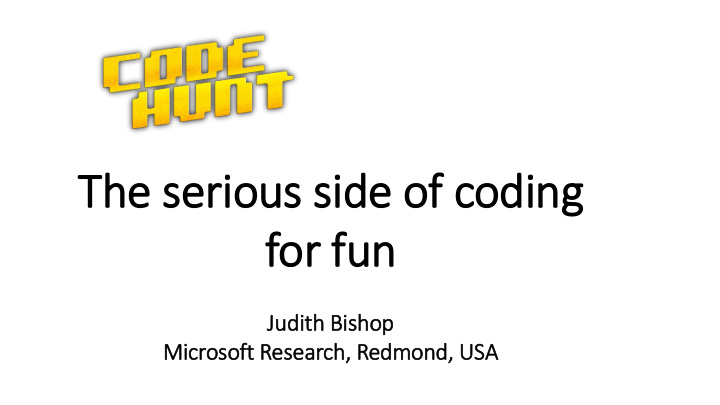



The serious sid ide of coding for fun Ju Judit ith Bis ishop Mic icrosoft Research, , Redmond, USA
Working for fun Enjoyment adds to long term retention on a task Discovery is a powerful driver, contrasting with direct instructions Gaming joins these two, and is hugely popular Can we add these elements to coding? Write a program to determine all the sets of effectively identical rooms in a maze. (A page of background, sample input and output given)
It’s a game! code iterative gameplay adaptive personalized test cases no cheating clear winning criterion
Audiences Students : proceed through a sequence on puzzles to learn and practice. Educators : exercise different parts of a curriculum, and track students ’ progress Recruiters: use contests to inspire communities and results to guide hiring Researchers : mine extensive data in Azure to evaluate how people code and learn
Code Hunt Usage Code Hunt has had several hundred thousands of users since launch in March 2014 Stats from Visual Studio Analytics over the period May 22-June 26 indicate 40,235 users Stickiness (loyalty) is very high
Last week
Period 3-10 October, 2014
Survey results (735 respondents) How much did the puzzle aspect of Code Hunt keep you interested in reaching a solution? We have many other statistics, but not so In your opinion, were your final solutions well-structured code? relevant to contests
Contest Goals identify top coders make online competitions more fun 2,353 41.0 players average tries per level 350 7.6 top players average tries per level
Creating new contests • Creating new puzzles • Requires curation of a puzzle bank • Original data about each puzzle • Group – numbers, arrays, strings, bools, binary • Subjective difficulty • Source – who wrote the puzzle • Features • Each contest should have a sequence of sectors in increasing difficulty • Avoid “Bad” puzzles early on – those that fool users
Leaderboard and Dashboard Visible only to the organizer Publically visible, updated during the contest
Code Hunt - the APCS (default) Zone • Opened in March 2014 • 129 problems covering the Advanced Placement Computer Science course • So far, over 45,000 users started. APCS Zone, First three sectors, 45K to 1K APCS Players, Sectors 4 to 14, 1.3K to 110 50000 45000 1600 40000 1400 35000 1200 30000 1000 Players Players 25000 800 20000 600 15000 400 10000 200 5000 0 0 4.1 4.4 4.7 4.10 5.1 5.4 6.2 6.5 6.8 6.11 7.2 7.6 7.9 8.2 8.5 8.8 9.3 9.6 9.9 9.13 10.2 10.5 10.8 11.3 11.6 12.2 12.5 12.8 13.1 13.4 14.3 14.6 1.1 1.2 1.3 1.4 1.5 1.6 1.7 1.8 1.9 1.10 1.11 1.12 1.13 1.14 1.15 2.1 2.2 2.3 2.4 2.5 2.6 2.7 3.1 3.2 3.3 3.4 3.5 3.6 3.7 3.8 Sector and Level Sector and Level
Updating the puzzle bank statistics • Updating the used field • Modifying the difficulty rating based on user experience • Options • Score – but the score is 1-3 and we know from the survey that 77% of users improve their code to get a 3 • Tries – a fairly objective reflection of how long it took to find the pattern and program a correct solution • CAVEAT!!! Users in areas with poor internet are known to use the Capture Code button less
Effect of difficulty on drop off in sectors 1-3 50 45 40 35 Percentage or 1000 Winners 30 25 20 15 10 5 0 1.1 1.2 1.3 1.4 1.5 1.6 1.7 1.8 1.9 1.10 1.11 1.12 1.13 1.14 1.15 2.1 2.2 2.3 2.4 2.5 2.6 2.7 3.1 3.2 3.3 3.4 3.5 3.6 3.7 3.8 Sector.Level Percentage drop off from previous Winners
Formula for perceived difficulty D = 1 + 8.88/20 + 8.88 * 29 / 1000 For a particular puzzle = 1.74 a + b * tries + c * tries * distance Original difficulty was 2 D= 1 + 45.08/20 + 45.08 * 69 / 1000 a = 1, b = 0.05, c = 0.02, or for APCS c = 0.001 = 6.36 tries are the average tries for all winners Original difficulty was 2 distance is the number of levels so far Examples 1683 8.88 3.8 376 45.08 7.8 Players Tries Sector.Level Players Tries Sector.Level
How players perceive difficulty BoP China (same community) a=1, b=0.05, c=0.02 Subjective Perceived Starting Ending Levels with difficulty difficulty players players average tries over 10 BoPQuali 1.59 2.86 13773 307 3 out of 17 = 18% BoPPrelimA 2.17 1.93 1017 125 3 out of 6 = 50% BoPPrelimB 2.50 1.97 141 131 2 out of 6 = 33% BoPSemi 2.60 2.49 1164 113 2 out of 10 = 20% CSTA and TEALS (identical contests) a=1, b=0.05, c=0.02 Subjective Perceived Starting Ending Levels with difficulty difficulty players players average tries over 10 TEALS (students) 1.96 5.22 61 3 5 out of 23 = 22% CSTA (teachers) 1.96 4.38 14 4 7 out of 23 = 30%
Planned Developments Technical enhancements Community engagement Catalog tool for puzzles New content semi-annually Editing tool for universes Working with contest Organizers Automatic testing tool for new Building a research community universes Building a user community Universe management tool Collecting usage statistics and Crowdsourcing puzzle creation answering bug reports Live feed showing active game play Website integrated dashboard Some of these can be done by Content testing of Office Mix plug in stakeholders/partners Maintaining the Java translator Support for user-defined types (objects) Management tool for data access Plug-in infrastructure for new APIs
Summary: Code Hunt: A Game for Coding For individuals (K12, introductory courses, geeks) For competitions at any level, world-wide or in house Based on long-term research on symbolic program analysis (Pex, Z3) Works with Java and C# www.codehunt.com Runs in any modern browser aka.ms/codehuntpolska Now working on tablets and phones
Recommend
More recommend